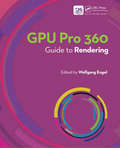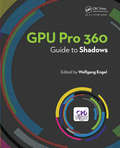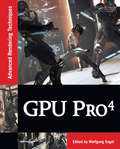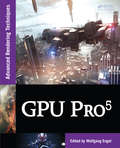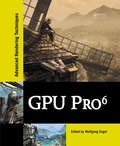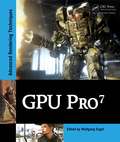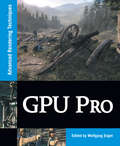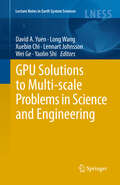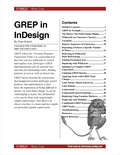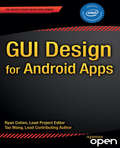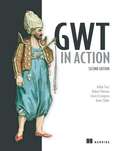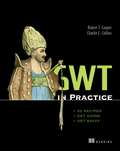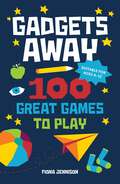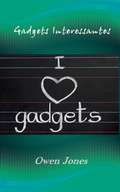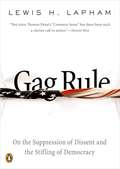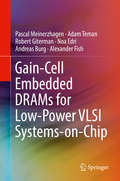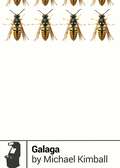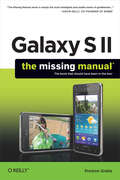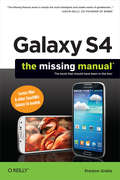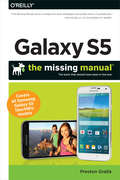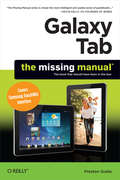- Table View
- List View
GPU Pro 360 Guide to Rendering
by Wolfgang EngelWolfgang Engel’s GPU Pro 360 Guide to Rendering gathers all the cutting-edge information from his previous seven GPU Pro volumes into a convenient single source anthology that covers real-time rendering. This volume is complete with 32 articles by leading programmers that focus on the ability of graphics processing units to process and generate rendering in exciting ways. GPU Pro 360 Guide to Rendering is comprised of ready-to-use ideas and efficient procedures that can help solve many rendering programming challenges that may arise. Key Features: Presents tips and tricks on real-time rendering of special effects and visualization data on common consumer software platforms such as PCs, video consoles, and mobile devices Covers specific challenges involved in creating games on various platforms Explores the latest developments in the rapidly evolving field of real-time rendering Takes a practical approach that helps graphics programmers solve their daily challenges
GPU Pro 360 Guide to Shadows
by Wolfgang EngelWolfgang Engel’s GPU Pro 360 Guide to Shadows gathers all the cutting-edge information from his previous seven GPU Pro volumes into a convenient single source anthology that covers various algorithms that are used to generate shadow data. This volume is complete with 15 articles by leading programmers that focus on achieving good visual results in rendering shadows. GPU Pro 360 Guide to Shadows is comprised of ready-to-use ideas and efficient procedures that can help solve many computer graphics programming challenges that may arise. <P><P>Key Features: <li>Presents tips & tricks on real-time rendering of special effects and visualization data on common consumer software platforms such as PCs, video consoles, mobile devices <li>Covers specific challenges involved in creating games on various platforms <li>Explores the latest developments in rapidly evolving field of real-time rendering <li>Takes practical approach that helps graphics programmers solve their daily challenges
GPU Pro 4: Advanced Rendering Techniques
by Wolfgang EngelGPU Pro4: Advanced Rendering Techniques presents ready-to-use ideas and procedures that can help solve many of your day-to-day graphics programming challenges. Focusing on interactive media and games, the book covers up-to-date methods for producing real-time graphics.Section editors Wolfgang Engel, Christopher Oat, Carsten Dachsbacher, Michal Vali
GPU Pro 5: Advanced Rendering Techniques
by Wolfgang EngelIn GPU Pro5: Advanced Rendering Techniques, section editors Wolfgang Engel, Christopher Oat, Carsten Dachsbacher, Michal Valient, Wessam Bahnassi, and Marius Bjorge have once again assembled a high-quality collection of cutting-edge techniques for advanced graphics processing unit (GPU) programming. Divided into six sections, the book covers render
GPU Pro 6: Advanced Rendering Techniques
by Wolfgang EngelThe latest edition of this bestselling game development reference offers proven tips and techniques for the real-time rendering of special effects and visualization data that are useful for beginners and seasoned game and graphics programmers alike.Exploring recent developments in the rapidly evolving field of real-time rendering, GPU Pro6: Advance
GPU Pro 7: Advanced Rendering Techniques
by Wolfgang EngelThe latest edition of this bestselling game development reference offers proven tips and techniques for the real-time rendering of special effects and visualization data that are useful for beginners and seasoned game and graphics programmers alike.Exploring recent developments in the rapidly evolving field of real-time rendering, GPU Pro 7: Advanc
GPU Pro: Advanced Rendering Techniques
by Wolfgang EngelThis book covers essential tools and techniques for programming the graphics processing unit. Brought to you by Wolfgang Engel and the same team of editors who made the ShaderX series a success, this volume covers advanced rendering techniques, engine design, GPGPU techniques, related mathematical techniques, and game postmortems. A special emphasi
GPU Solutions to Multi-scale Problems in Science and Engineering
by David A. Yuen Wei Ge Lennart Johnsson Long Wang Xuebin Chi Yaolin ShiThis book covers the new topic of GPU computing with many applications involved, taken from diverse fields such as networking, seismology, fluid mechanics, nano-materials, data-mining , earthquakes ,mantle convection, visualization. It will show the public why GPU computing is important and easy to use. It will offer a reason why GPU computing is useful and how to implement codes in an everyday situation.
GREP in InDesign
by Peter KahrelUpdated: June 2013. Author Peter Kahrel updated this Short Cut to cover InDesign CC. Several examples have been added, and most examples are now analysed in more detail.Author note: In Adobe InDesign CS6, GREP has not changed at all. Therefore, the information in this title is valid and up to date for CS6.Updated: August 2010. Author Peter Kahrel updated this Short Cut to cover InDesign CS5.Updated: November 2009. Author Peter Kahrel updated this Short Cut to address typos and reader comments.GREP (short for "General Regular-Expression Print") is a powerful tool that lets you use wildcards ("jokers") to search and replace text. InDesign's GREP implementation can be used for text and also for formatting codes, finding patterns in text as well as literal text.GREP moves beyond the restrictions that hampered earlier InDesign search features, but unfortunately it does have the reputation of being difficult to master. As with many things, it can be challenging to learn, but, fortunately, a lot can be done with surprisingly simple expressions. The aim of this Short Cut is to show how to create simple but powerful regular expressions.
GT Racing 2 Guía No Oficial
by Joshua Abbott I. FernándezGUÍA NO OFICIAL Además de comprar el libro puedes registrarte para entrar en nuestro programa de suplementos para las guías. Pinchando en el link que te mostramos a continuación puedes acceder a las últimas actualizaciones sobre las apps y videojuegos más populares. Regístrate gratis aquí: http://emailsignupform.subscribemenow.com/ Guía con consejos avanzados y estrategia. Es la guía más completa y detallada que encontrarás en la red. Disponible en descarga instantánea en tu teléfono móvil, dispositivo para ebooks o en papel. Tras el éxito de mis cientos de guías y estrategias, he vuelto a escribir otra guía profesional y avanzada para jugadores nuevos y veteranos. Encontrarás estrategias específicas y consejos sobre cómo ir avanzando en el juego, vencer a tus adversarios conseguir más dinero y mucho más. Esto es lo que obtendrás al comprar esta guía profesional, avanzada y detallada. *Consejos y estrategias profesionales. *Trucos *Secretos, consejos y trucos que utilizan los jugadores pro. *Cómo conseguir muchísimas monedas. *¡Y mucho más! Todas las versiones de esta guía tienen capturas de pantalla para ayudarte a entender mejor el juego. No hay otra guía que sea tan completa y avanzada como esta. Te alegrarás de haber comprado esta guía y te beneficiarás excepcionalmente en comparación con otras guías menos eficientes que hay en el mercado. ¡Cómprala ya y destroza a tus adversarios! ¡Conviértete en un jugador pro hoy mismo! Si necesitas ayuda o más información sobre nuestros productos visita www.hiddenstuffentertainment.com/ Descargo de responsabilidad Este producto no está asociado, afiliado, promocionado, certificado o financiado por el propietario original del copyright. Todas las marcas y marcas registradas que aparecen en este libro son propied
GUI Design for Android Apps
by Tao Wang Ryan CohenGUI Design for Android Apps is the perfect and concise introduction for mobile app developers and designers. Through easy-to-follow tutorials, code samples, and case studies, the book shows the must-know principles for user-interface design for Android apps running on the Intel platform, including smartphones, tablets and embedded devices. This book is jointly developed for individual learning by Intel Software College and China Shanghai JiaoTong University, and is excerpted from Android Application Development for the Intel(r) Platform. What you'll learnKey aspects of why UI and UX design for embedded systems is different than for desktopsTroubleshooting UI design issuesUnderstanding how key concepts such as state transition, context class, and intent workHow to use the interface app design tools provided by AndroidPlanning for complex apps (apps with multiple activities)Optimizing app design for touch screen inputWho this book is for The book is primarily for app developers, software engineers and open-source programming enthusiasts, but can also be used by for training programs and Codeacademy-style programs. Table of ContentsForeword/PrefaceChapter 1. General OverviewChapter 2. The Android-Specific GUIChapter 3. Designing Complex ApplicationsChapter 4. Self-Drawing Graphics and Touch Screen InputConclusion"
GWT in Action
by Robert Hanson Jason Essington Anna Tokke Adam TacySummaryGWT in Action, Second Edition is a completely revised edition of the best-selling GWT book. It covers the new features introduced in GWT 2.4 and 2.5, as well as the best development practices that have emerged in the GWT community. It begins with a rapid-fire introduction to GWT and Ajax to get you up to speed with GWT concepts and tools. Then, you'll explore key concepts like managing events, interacting with the server, creating UI components, building your user interface declaratively using UiBinder ... and more.About the TechnologyGoogle Web Toolkit works on a simple idea. Write your web application in Java, and GWT crosscompiles it into JavaScript. It is open source, supported by Google, and version 2.5 now includes a library of high-quality interface components and productivity tools that make using GWT a snap. The JavaScript it produces is really good.About this BookGWT in Action, Second Edition is a revised edition of the best-selling GWT book. In it, you'll explore key concepts like managing events, interacting with the server, and creating UI components. As you move through its engaging examples, you'll absorb the latest thinking in application design and industry-grade best practices, such as implementing MVP, using dependency injection, and code optimization. Written for Java developers, the book requires no prior knowledge of GWT. Purchase of the print book comes with an offer of a free PDF, ePub, and Kindle eBook from Manning. Also available is all code from the book.What's InsideCovers GWT 2.4 and upEfficient use of large data setsOptimizing with client bundles, deferred binding, and code splittingUsing generators and dependency injectionAbout the AuthorsAdam Tacy and Robert Hanson coauthored the first edition of GWT in Action. Jason Essington is a Java developer and an active contributor to the GWT mailing list and the GWT IRC channel. Anna Tökke is a programmer and solutions architect working with GWT on a daily basis.Table of ContentsPART 1 BASICSGWTBuilding a GWT application: saying "Hello World!"Building a GWT application: enhancing Hello WorldPART 2 NEXT STEPSCreating your own widgetsUsing client bundlesInterface design with UiBinderCommunicating with GWT-RPCUsing RequestFactoryThe Editor frameworkData-presentation (cell) widgetsUsing JSNI—JavaScript Native InterfaceClassic Ajax and HTML formsInternationalization, localization, and accessibilityPART 3 ADVANCEDAdvanced event handling and event bussesBuilding MVP-based applicationsDependency injectionDeferred bindingGeneratorsMetrics and code splitting
GWT in Practice
by Robert Cooper Charlie CollinsIf you're a web developer, you know that you can use Ajax to add rich, user-friendly, dynamic features to your applications. With the Google Web Toolkit (GWT), a new Ajax tool from Google that automatically converts Java to JavaScript, you can build Ajax applications using the Java language.GWT in Practice is an example-driven, code-rich book designed for web developers already familiar with the basics of GWT who now want hands-on experience. After a quick review of GWT fundamentals, GWT in Practice presents scores of handy, reusable solutions to the problems you face when you need to move beyond "Hello World" and "proof of concept" applications. This book skips the theory and looks at the way things really work when you're building. I also shows you where GWT fits into the Enterprise Java Developer's toolset. Written by expert authors Robert Cooper and Charlie Collins, this book combines sharp insight with hard-won experience. Readers will find thorough coverage of all aspects of GWT development from the basic GWT concepts to in depth real world example applications.The first part of the book is a rapid introduction to the GWT methodology The second part of the book then delves into several practical examples which further demonstrate core aspects of the toolkit The book concludes by presenting several larger GWT applications including drag and drop support for UI elements, data binding, processing streaming data, handling application state, automated builds, and continuous integration.Along the way GWT in Practice covers many additional facets of working with the toolkit. Various development tools are used throughout the book, including Eclipse, NetBeans, IDEA, Ant, Maven, and, of course, the old fashioned command line. The book also addresses integrating GWT with existing applications and services along with enterprise and team development.
Gadget Interessanti (Come fare... #28)
by Owen JonesGli articoli presenti in questo ebook sono suggerimenti e consigli su gadget, strumenti interessanti anche per gli adulti e argomenti simili. Tuttavia, il libro dovrebbe essere considerato nella sua totalità. Il testo è composto su diversi livelli: spero che troverai le sue informazioni utili, e inoltre, comprandolo, potrai anche usarne i contenuti nelle tue pubblicazioni.
Gadgets Away: 100 Games To Play With The Family
by Fiona JennisonTechnology has become the too-easy way to entertain ourselves and our children. This easy-to-use, imaginative book has everything. There’s plenty of fun here to keep your family laughing: Sporty games and playground classics Activities for indoors, gardens, parks and beaches Memory and travel games, brain teasers and magic tricks
Gadgets Interessantes (Como fazer... #28)
by Owen JonesGadgets Interessantes Olá e obrigado por comprar este ebook chamado "Gadgets Interessantes". Espero que você ache as informações prestativas, úteis e lucrativas. As informações contidas neste e-book sobre vários tipos de gadgets, brinquedos para adultos e assuntos relacionados estão organizadas em 16 capítulos com cerca de 500 a 600 palavras cada. Espero que seja do interesse de quem gosta de tecnologia moderna e de gadgets. Como um bónus adicional, concedo-lhe a permissão para usar o conteúdo no seu próprio site ou nos seus próprios blogs e newsleters, embora seja melhor se antes você os reescrever com as suas próprias palavras. Você também pode dividir o livro e revender os artigos. De facto, o único direito que você não tem é revender ou doar o livro como ele lhe foi entregue. Se você tiver algum comentário, deixe-o na empresa onde você comprou este livro. Você também encontrará mais livros como este por lá. Agradecemos novamente por adquirir este ebook, Saudações, Owen Jones
Gag Rule: On the Suppression of Dissent and the Stifling of Democracy
by Lewis LaphamLapham issues a call to action in defense of one of our most important liberties--the right to raise our voices against the powers that be and have those voices heard.
Gagner un revenu passif avec Quora et démissionner de votre emploi actuel
by Marcus PfeifferMake passive income with quora and quit your job Gagner un revenu passif avec Quora et démissionner de votre emploi actuel de Marcus Pfeiffer Comment devenir riche en ligne (se faire de l’argent en ligne Livre 1) Guide pour se faire de l’argent en ligne avec Quora Voulez-vous gagner de l'argent en ligne tout en restant dans le confort de votre foyer ? Mais malgré vos heures de dur labeur, vous avez toujours du mal à la fin du mois. Croyez-moi, il y a quelques années, je me trouvais exactement dans la même situation que vous. J’avais visité tous les sites d’internet du monde entier dans l’espoir de comprendre comment gagner de l'argent en ligne. Mais, je n'avais gagné aucun centime. Pire encore, j’étais même arrivé à perdre des sommes monstrueuses dans des cours, des publicités, des sites Web, des livres et de mauvais investissements. Mais heureusement, un jour, je suis tombé sur une méthode qui m'a aidé à gagner un revenu passif. Ne vous méprenez pas, passif ne signifie pas que vous n’aurait aucun travail à faire. Ce que je veux dire par là est qu'une fois que vous avez travaillé dur, l'argent coulera à flot suite à peu d’efforts de votre part. Mais pour y arriver, au début, vous devez consacrer plusieurs heures de travail très acharné. Dans ce livre, je vous expliquerai l'approche que j'ai utilisée pour faire fortune. Et je vous promets que si vous suivez mes instructions, vos efforts seront récompensés.
Gain-Cell Embedded DRAMs for Low-Power VLSI Systems-on-Chip
by Pascal Meinerzhagen Adam Teman Robert Giterman Noa Edri Andreas Burg Alexander FishThis book pioneers the field of gain-cell embedded DRAM (GC-eDRAM) design for low-power VLSI systems-on-chip (SoCs). Novel GC-eDRAMs are specifically designed and optimized for a range of low-power VLSI SoCs, ranging from ultra-low power to power-aware high-performance applications. After a detailed review of prior-art GC-eDRAMs, an analytical retention time distribution model is introduced and validated by silicon measurements, which is key for low-power GC-eDRAM design. The book then investigates supply voltage scaling and near-threshold voltage (NTV) operation of a conventional gain cell (GC), before presenting novel GC circuit and assist techniques for NTV operation, including a 3-transistor full transmission-gate write port, reverse body biasing (RBB), and a replica technique for optimum refresh timing. Next, conventional GC bitcells are evaluated under aggressive technology and voltage scaling (down to the subthreshold domain), before novel bitcells for aggressively scaled CMOS nodes and soft-error tolerance as presented, including a 4-transistor GC with partial internal feedback and a 4-transistor GC with built-in redundancy.
Galaga (Boss Fight Books)
by Michael KimballFor fifteen seconds of one of the highest-grossing films of all time, The Avengers&’ plan to save the world comes to a grinding halt when Tony Stark calls out a low-level member of S.H.I.E.L.D. for playing Galaga on the job. Acclaimed novelist and lifelong Galaga player Michael Kimball knows the compulsion: He&’s set and re-set high scores on Galaga machines all across America. What many call the greatest fixed shooter arcade game in history, Galaga broke the Space Invaders mold with superior graphics, faster firing, bonus rounds, tractor beams, and advanced enemy A.I. Since its 1981 release, Galaga has inspired numerous sequels, bootlegs, hacks, and clones—and some version of Galaga has been released for nearly every gaming platform. Kimball shares his obsession with Galaga through a discussion of the innovative gameplay it introduced (including lots of tips), its extensive cultural legacy (including collectibles, movies, rap songs, drinking games, and sex acts), and how Galaga got Kimball through a difficult childhood--and maybe saved his life.
Galaxy S II: The Missing Manual
by Preston GrallaUnlock the potential of Samsung's Galaxy S II with this jargon-free guide from technology guru Preston Gralla. You’ll quickly learn how to shoot high-res photos and HD video, keep your schedule, stay in touch, and enjoy your favorite media. Every page is packed with illustrations and valuable advice to help you get the most from the smartest phone in town. (Note: This book does not cover the Galaxy S3, Galaxy S4, and later models.)The important stuff you need to know:Get dialed in. Learn your way around the Galaxy S II’s calling and texting features.Go online. Browse the Web, manage email, and download apps with Galaxy S II’s 3G/4G network (or create your own hotspot).Master your media. Shoot and share pictures and video, organize and play your music library—and send it wirelessly to your TV or stereo.Be entertained now. Start watching movies and TV shows while they’re still loading.Explore the world. Get news and weather, find a location, and navigate by GPS.Check your schedule. Use the convenient calendar app, and sync it with your Google and Outlook calendars.Preston Gralla is the author of more than 40 books, including Missing Manuals on Droid X2, Xoom, and Galaxy Tab. He’s the editor of WindowsDevCenter.com and OnDotNet, and a contributing editor to Computerworld.
Galaxy S4: The Missing Manual
by Preston GrallaGalaxy S4 is amazing right out of the box, but if you want to get the most of out your S4 or S4 Mini, start here. With clear instructions and savvy advice from technology expert Preston Gralla, you’ll learn how to go online, play games, listen to music, watch movies & TV, monitor your health, and answer calls with a wave of your hand.The important stuff you need to know:Be connected. Browse the Web, manage email, and download apps through WiFi or S4’s 3G/4G network.Navigate without touch. Use Air Gestures with your hand, or scroll with your eyes using Smart Screen.Find new ways to link up. Chat, videochat, and add photos, video, or entire slideshows to text messages.Get together with Group Play. Play games or share pictures, documents, and music with others nearby.Create amazing images. Shoot and edit photos and videos—and combine images from the front and back cameras.Keep music in the cloud. Use Google Play Music to store and access tunes.Check your schedule. Sync the S4 with your Google and Outlook calendars.
Galaxy S5: The Missing Manual
by Preston GrallaGet the most out of Samsung’s Galaxy S5 smartphone right from the start. With clear instructions from technology expert Preston Gralla, this Missing Manual gives you a guided tour of Samsung's new flagship phone, including great new features such as the fingerprint scanner, heart rate sensor, and Download Booster. You’ll get expert tips and tricks for playing music, calling and texting, shooting photos and videos, and even getting some work done.The important stuff you need to know:Get connected. Browse the Web, manage email, and download apps from Google Play through WiFi or 3G/4G network.Keep in touch. Call, text, chat, videochat, conduct conference calls, and reach out with Facebook and Twitter.Capture and display images. Shoot, edit, show, and share photos, slideshows, and high-definition videos.Play and manage your music. Buy music from Google Play or Amazon and listen to it with Galaxy S5’s Music app.Work anywhere. Access your files, company network, calendar, and contacts—and work with Google Docs.Connect to Google Maps. Use geolocation and turn-by-turn drive directions to find your way.Stay fit with S Health. Use this built-in app to keep track of fitness goals, walking, heart rate, blood pressure, and more.
Galaxy Tab: Covers Samsung TouchWiz Interface (The\missing Manual Ser.)
by Preston GrallaGalaxy Tab lets you work, play, read, and connect on the go, but mastering its TouchWiz interface and finding the best apps can be tricky—unless you have this Missing Manual. Gadget whiz Preston Gralla provides crystal-clear explanations and step-by-step instructions to get you up to speed quickly, whether you have the 3G/4G or Wi-Fi version of this amazing device.The important stuff you need to know:Design your experience. Add interactive widgets and mini-apps to your screen with TouchWiz.Satisfy your appetite. Download thousands of games and apps from the Android Market.Keep in touch. Chat, videochat, check email, and browse the Web.Find your way. View maps, use the GPS, and navigate turn-by-turn.Manage your media. Shoot and view photos and videos; organize and play your music.Stay informed. Read books, newspapers, and magazines.Be productive. Use Google Docs to store and share documents.
Gallo de día murciélago de noche: Momentos únicos, anécdotas y experiencias en carretera
by Toni Aguilar Dani Moreno Xavi RodríguezEl mágico mundo de la radio ¿Quién no se sentiría orgulloso de levantarse un lunes sabiendo que lo que hace puede cambiar la vida de alguien para mejor? Dani Moreno, radioDJ de Máxima FM, pagaría por ir a trabajar cada día a la radio porque no puede vivir sin ella. En Gallo de día# murciélago de noche encontraremos sus veinte años de carrera como locutor y como DJ. Lo que le ha sucedido delante y detrás de un micrófono, en el escenario, en el estudio, durante las entrevistas a personajes famosos, en el backstage, en la producción, en la publicidad, en las cabinas, en los hoteles, durante los viajes, en los programas en directo, de clubbing. Anécdotas y experiencias diurnas y nocturnas, los oyentes, los mejores DJ del mundo y el reconocimiento: el premio Ondas. Un libro divertido repleto de momentos radiofónicos estelares y sesiones de infarto que surge de la pasión por la música, lleno de positivismo y energía, en el que el Gallo Máximo te cuenta cómo se hizo realidadsu sueño. Una experiencia de lectura interactiva en la que los lectores más marchosos pueden disfrutar -a través de códigos QR- de vídeos en exclusiva, videoclips y de los momentos memorables de Dani Moreno.
